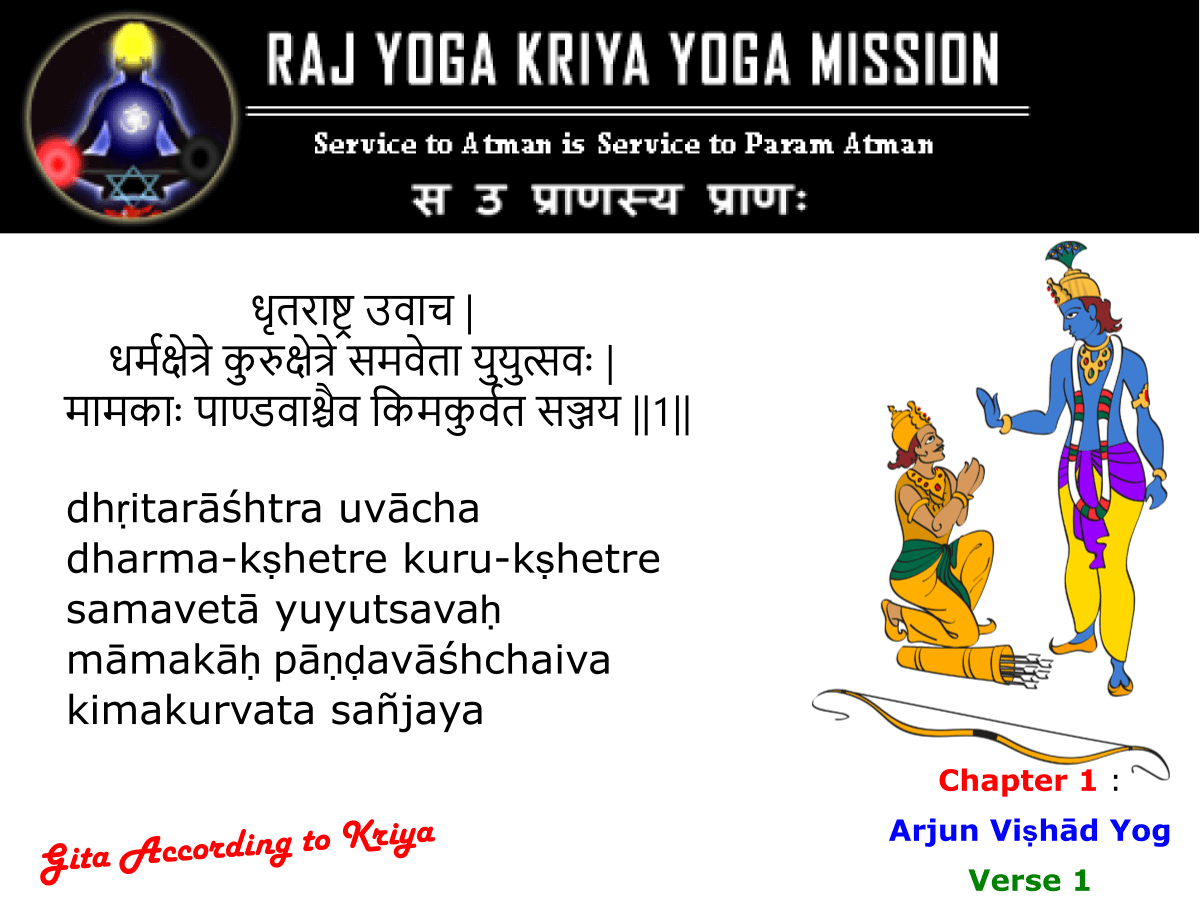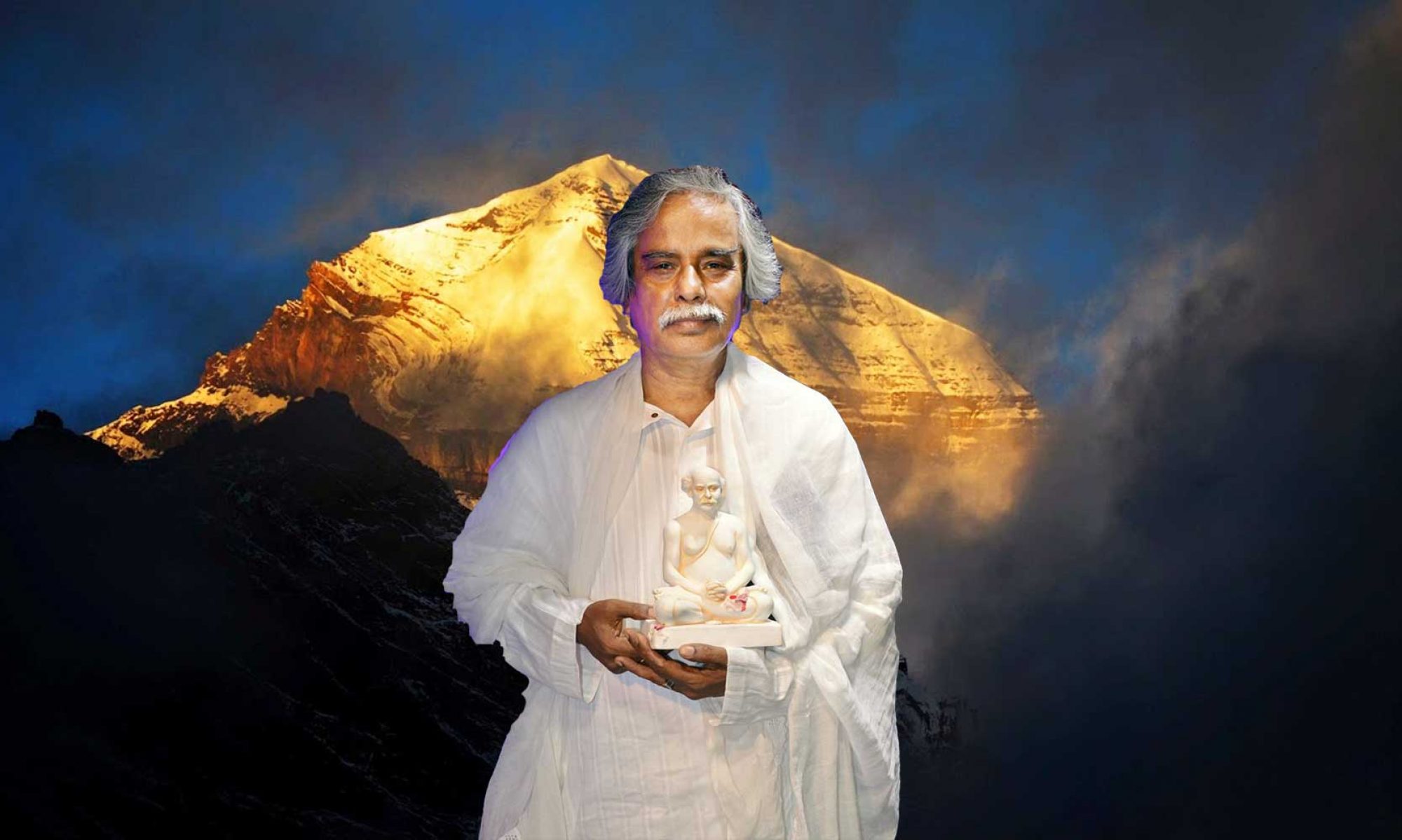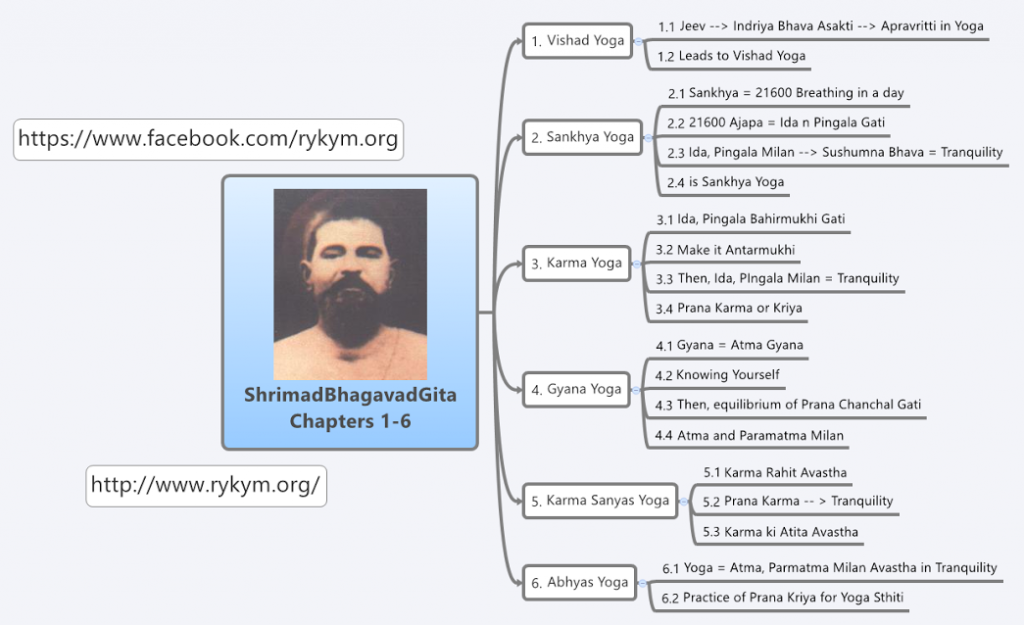ধৃতরাষ্ট উবাচ
ধর্মক্ষেত্রে কুরুক্ষেত্রে সমবেতা যুযুত্সবঃ ।
মামকাঃ পান্ডবাঃ চ এব কিম অকুর্বত সঞ্জয় ।।১
অর্থ-ধৃতরাষ্ট জিজ্ঞাসা করলেন হে সঞ্জয় ধর্মক্ষেত্রে যুদ্ধ করার মানসে সমবেত হয়ে আমার পুত্র এবং পান্ডুর পুত্ররা তারপর কি করলেন।
ক্রিয়াযোগ অনুসারে ব্যাখ্যা : দেহরূপ রাজ্য যিনি ধারণ করে আছেন, তিনিই ধৃতরাষ্ট্র ; মন এই দেহরূপ রাজ্যের রাজা । এই মন অন্ধ কিছুই দেখতে পারে না । বুদ্ধির দ্বারা ভালো, মন্দ বিষয় গোচর হইয়া থাকে ।অন্ধ মনের দৃষ্টি-হীনতা হেতু মন যুদ্ধের বিষয় সঞ্জয়কে জিজ্ঞাসা করছেন । সঞ্জয় অর্থাৎ সম্যক প্রকারে জয় হলে যার প্রকাশ হয় অর্থাৎ দিব্যদৃষ্টি অথবা অন্তর্দর্শন । ধর্মক্ষেত্রে অর্থাৎ এই শরীর; এই শরীরই ধর্মক্ষেত্র এবং কর্মভূমি । কারণ ধর্ম আর কর্ম মিলেই এই শরীর । লাহিড়ী মহাশয় বলিয়াছেন জীবের প্রতি দয়াই ধর্ম |
দয়া, যাহাতে জীবের রক্ষা বা পোষণ হয় । রক্ষা অর্থাৎ স্থিতি , স্বাস প্রস্বাসরুপে প্রাণের যে গতি চলিতেছে এই গতি স্বতঃ রহিত (স্থির ) অবস্থার নাম স্থিতি । অর্থাৎ বিনা অবরোধ আপনা আপনি স্বাস স্থির অবস্থার নাম স্থিতি । এই স্থিতি প্রাণকর্ম বা প্রাণায়াম দ্বারাই সম্ভব এবং সেই ক্রিয়া এই শরীরে হয় তাই শরীরকে ধর্মক্ষেত্র এবং প্রাণকর্মের কর্মভূমি বলিয়া কুরুক্ষেত্র বলা হয়েছে ।
এই শরীররূপ ক্ষেত্রে যুদ্ধার্থী মনের পক্ষিয়গন অর্থাৎ ইন্দ্রিয়গণ , কারণ ইন্দ্রিয়গণকেই মন নিজের বলিয়া বোধ কোরিয়া থাকে । বাক , পাণি , পাদ, পায়ু এবং উপস্থ এই পঞ্চ স্থানই কর্মেন্দ্রিয় ; চক্ষু, কর্ণ , নাসিকা , জিব্হা, ত্বক এই পাঁচজ্ঞানেন্দ্রিয় , এক সাথে এরা দশ ইন্দ্রীয় যারা প্রত্যেকেই (পূর্ব পশ্চিমাদি ) দশ দিকে গতিশীল । মনরূপী ধৃতরাষ্ট্রের এই (১০ * ১০ = ১০০) একশত পুত্র । ইহারাই মনের প্রবৃত্তিপক্ষীয় ।
পাণ্ডব অর্থাৎ সৎবুদ্ধির (পাণ্ডর) সন্তান, পাণ্ডবগণ অর্থাৎ ক্ষিতি, তপ, তেজঃ, মরুৎ , ব্যোম এই পঞ্চ তত্বই পঞ্চ পাণ্ডব ইহারাই মনের নির্বিতিপক্ষই ।প্রাণক্রিয়া আরম্ভ হইলে পঞ্চতত্বের গুণসমূহ এবং ইন্দ্রিয়গত সমবেত হইয়া কি করিলেন , তাহাইদিব্যদৃষ্টির সাহায্যে অন্ধমন জানিতে চাহিতেছেন ।।১
धृतराष्ट्र उवाच |
धर्मक्षेत्रे कुरुक्षेत्रे समवेता युयुत्सवः |
मामकाः पाण्डवाश्चैव किमकुर्वत सञ्जय ||1||
भावार्थ : धृतराष्ट्र बोले- हे संजय! धर्मभूमि कुरुक्षेत्र में एकत्रित, युद्ध की इच्छावाले मेरे और पाण्डु के पुत्रों ने क्या किया?॥1॥
क्रियायोग के अनुसार व्याख्या: देहरूपी राज्य को जो धारण किए हुए है वो धृतराष्ट्र है | मन इस देहरूपी राज्य का राजा है , यह मन जन्म से ही अँधा है और कुछ भी देखने में अक्षम है | यह मन बुद्धि की सहयता से विषयों का भोग करता है | अपनी दृष्टीबाधिता के कारण मन युद्ध के विषय में सञ्जय से जिज्ञासा कर रहा है | सञ्जय अर्थात दिव्यदृष्टि या अंतर्दर्शन की शक्ति | धर्मक्षेत्र अर्थात ये शरीर ; यह शरीर ही हमारा धर्मक्षेत्र और कर्मभूमि है , धर्म और कर्म से ही इस शरीर का अस्तित्व है | लाहिड़ी महाशय ने दया को ही धर्म की संज्ञा दी है |
दया वो कर्म है जिससे जीव की रक्षा एवं पोषण होता है| रक्षा अर्थात स्थिति, प्राण श्वाश-प्रश्वाश रूप में गतिशील है और जब इसकी गति स्वतः स्थिर अवस्था को प्राप्त होती है उसे स्थिति कहते है | प्राण को स्थिर करने का एकमात्र उपाय है प्राणकर्म या प्राणायाम | इसी प्राणायाम क्रिया के कारण ही शरीर को क्रियाक्षेत्र या कुरुक्षेत्र कहा गया है |
इस शरीर क्षेत्र में युद्ध की अभिलाषा रखने वाले कौरव अर्थात इन्द्रियगण | यह मन इन्ही इन्द्रियों को अपना समझता है और सदा इनके वशीभूत रहता है | वाक्, पाणि, पायु, पाद, उपस्थ ये पांच स्थान कर्मेन्द्रियों का हैं | चक्षु, कर्ण, नासिका, जिह्वा, त्वक् ये पांच ज्ञानेन्द्रियाँ है | कुल मिलाके ये दस इन्द्रिया (पूर्व , पश्चिमादि ) दसो दिशाओ में गतिशील है | मन रूपी धृतराष्ट्र के ये (१० *१० =१०० ) सौ पुत्र है | ये कौरव मन की प्रवृत्तिया हैं और मन इसी में सदा मग्न रहना चाहता है |
पाण्डवगण अर्थात पाण्डु (सतबुद्धि )की संतान, पाण्डवगण पृथ्वी, तप , तेज, मारुत , व्योम ये पंचतत्व ही पांडव के रूपक है | ये मन की निवृत्तिया है | क्रियायोग के दीक्षा के उपरांत साधक प्राणकर्म /प्राणायाम का अभ्यास करना प्रारम्भ करता है जिससे मन की चंचलता प्रारम्भ में बढ़ती है और वो अंतरमुखि होकर अपने इन्द्रिय रूपी पुत्रो और पंचतत्वों के मध्य चल रहे युद्ध की स्थिति के विषय में दिव्यदृष्टि से पूछता है |
dhṛitarāśhtra uvācha
dharma-kṣhetre kuru-kṣhetre samavetā yuyutsavaḥ
māmakāḥ pāṇḍavāśhchaiva kimakurvata sañjaya ||1||
Meaning: Dhritarashtra said: O Sanjay, after gathering on the holy field of Kurukshetra, and desiring to fight, what did my sons and the sons of Pandu do?
Explanation accordding to Kriya Yoga: Dhṛitarāśhtra, the blind king, is ruler of bodily kingdom. Here mind (mana), is allegorically represented as Dhṛitarāśhtra, who upholds the kingdom of senses. The mind considered as blind because it cannot see anything without the help of senses and intellect. Blind from birth and bereft of spiritual wisdom, Dhṛitarāśhtra turns to Sanjya (one who has conquered himself) for an unbiased report on current development in Kurukshetra, here Sanjaya allegorically represented as divine-insight. Dharma-kṣhetre (field of righteous battle) and Kurukshetra (field of action) allegorically signifies as inner physical body. According to Lahiri Mahashaya having compassion for all being is real Dharma.
Compassion protect and nurture all living beings without exception from their suffering. According to Kriya one should develop self-compassion first, which eventually transform into the compassion for others. Here protection means reaching a state of stillness, when breath flows through body without any effort. Through proper practise of Pranayama (conscious awareness of breath) one can achieve a breathless state. This Pranayama happens within our body that is why it called Kurukshetra (field of action).
Competing in Kurukshetra are two opposing forces: offspring of discriminative intelligence (Buddhi/Pandu) and sense conscious mind (Dhṛitarāśhtra). The five karmendriya (‘organ of action’) or active-senses are vak-tattva: speech (voice), pani-tattva: grasping (hands), pada-tattva: walking (feet), payu-tattva: excretion (anus) and upastha-tattva: procreation (genitals). The five sense organs are eyes, ears, tongue, skin, and nose. Together they are 10 senses which are always active in 10 direction (North - उत्तर - Uttar, East - पूर्व - Purva, West - पश्चिम - Pashchim, South - दक्षिण - Dakshin, North-East - ईशान - Ishanya, South-East - अग्नि - Agneya, South-West - नैऋत्य - Nairutya, North-West - वायु - Vayavya, Skywards - ऊर्ध्व - Urdhwa/ Akash, and Downwards - अधरस्त - Adharastha/ Patal ; comprises (10*10=100) hundred sons of Dhṛitarāśhtra. Kauravas represented as pravritti, inclination towards worldly enjoyment.
Sons of Pandu (Pandavas) represent 5 elements; ether, air, fire, water and earth. Pandavas upholds righteous principal of nirvritti (renunciation of worldliness). After kriya initiation, as soon as the spiritual aspirant tries to meditate; sense organs retaliate, which are then confronted by self-control and discrimination, and the battle begins.



